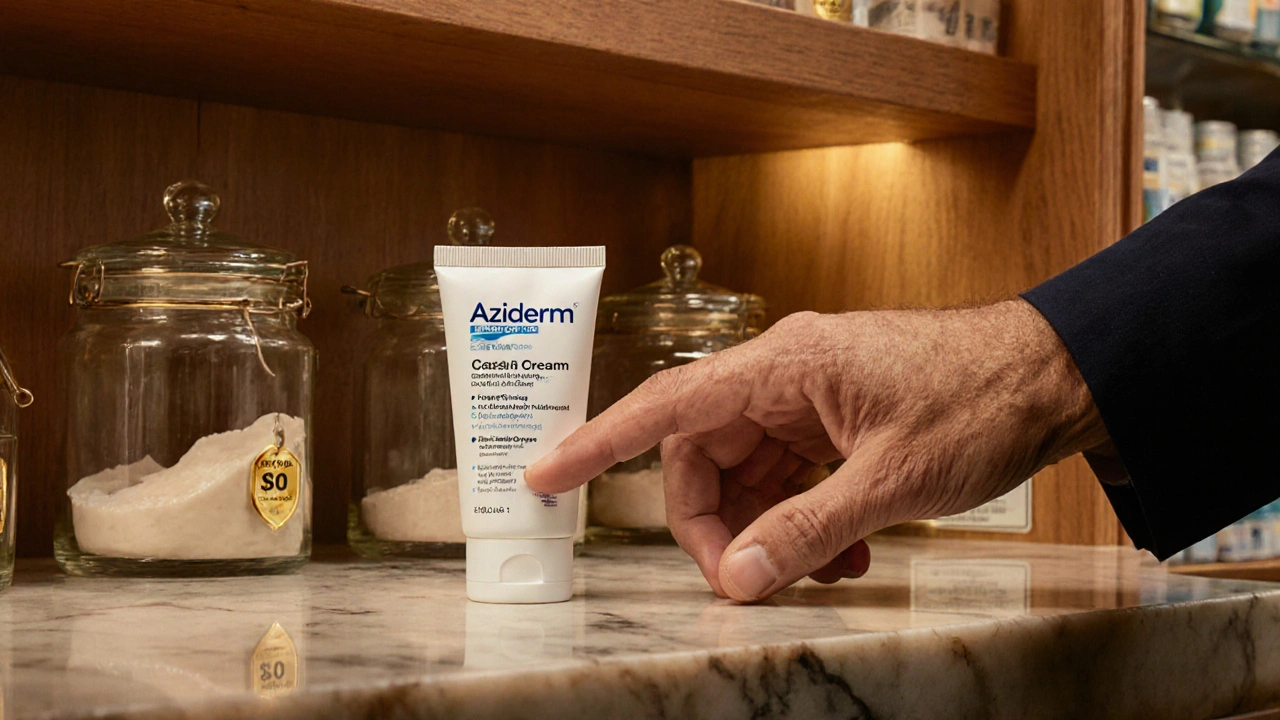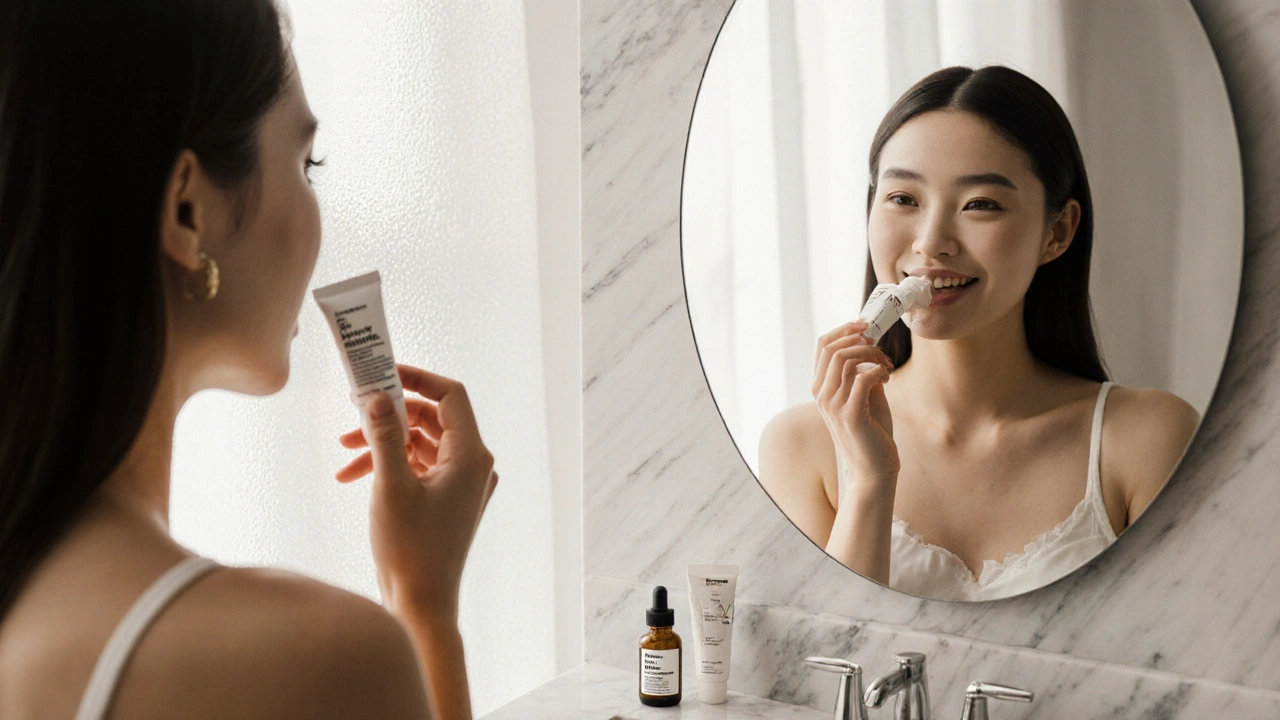Azelaic Acid Product Selector
Answer the questions below to find the best azelaic acid product for your needs.
1. What is your primary skin concern?
2. How sensitive is your skin?
3. What is your budget range?
4. Do you have a prescription available?
Your Recommended Product:
Aziderm Cream has become a go‑to for many battling acne, rosacea, or hyperpigmentation, but the market is crowded with other azelaic‑based or acne‑focused products. Below is a quick snapshot so you can decide if it’s the right fit for you.
- Aziderm delivers a prescription‑strength 20% azelaic acid dose.
- Alternatives range from over‑the‑counter 10% azelaic serums to benzoyl‑peroxide gels.
- Key factors: concentration, irritation potential, price, and additional actives.
- Best for sensitive skin? Look for soothing niacinamide blends.
- Best for stubborn acne? Consider retinoid‑combined formulas.
What Is Aziderm Cream?
When you read the label, Aziderm Cream is a prescription‑only gel containing 20% azelaic acid, designed to reduce inflammation, kill acne‑causing bacteria, and fade dark spots. First launched in the UK in 2016, it quickly earned a reputation for delivering clinically proven results with relatively low irritation compared to stronger retinoids.
Azelaic acid works by normalising keratinisation, inhibiting the growth of Propionibacterium acnes, and acting as an antioxidant. The 20% concentration is enough to make a noticeable difference in 4‑6 weeks for most users.
Top Alternatives on the Market
Below are the most popular over‑the‑counter and prescription options that people compare against Aziderm:
- Paula's Choice 10% Azelaic Acid - a lightweight lotion with added soothing botanicals.
- The Ordinary Azelaic Acid Suspension 10% - an affordable, minimalist gel that doubles as a brightening serum.
- Differin Gel (Adapalene 0.1%) - a retinoid that targets comedones and inflammation.
- PanOxyl 10% Benzoyl Peroxide Wash - a potent antibacterial wash for breakout‑prone skin.
- La Roche‑Posay Effaclar Duo+ - a dual‑action acne spot treatment with niacinamide.
- CeraVe Resurfacing Retinol Serum - a low‑strength retinol blended with ceramides for barrier support.
- Neutrogena Rapid Wrinkle Repair - a retinol cream that some users repurpose for acne control.
- Bioderma Sébium Global - a daily fluid that combines zinc gluconate and salicylic acid.
How to Compare - Decision Criteria
When weighing Aziderm against its rivals, focus on these measurable criteria:
- Active concentration: Higher percentages usually mean faster results, but also higher irritation risk.
- Irritation profile: Look for soothing agents like niacinamide, allantoin, or ceramides.
- Formulation type: Gel vs cream vs serum affects absorption and suitability for oily vs dry skin.
- Additional actives: Some products pair azelaic acid with salicylic acid, retinoids, or vitamin C for synergistic benefits.
- Cost per month: Prescription products may be cheaper per gram but require a doctor’s visit; OTC alternatives vary widely.
- Availability: Do you need a pharmacy, a dermatologist, or can you buy it online?
Side‑by‑Side Comparison Table
| Product | Active(s) | Concentration | Typical Price (UK) | Irritation Risk | Best For |
|---|---|---|---|---|---|
| Aziderm Cream | Azelaic Acid | 20% | £25‑£30 for 30g (prescription) | Low‑moderate | Acne, rosacea, melasma |
| Paula's Choice 10% Azelaic Acid | Azelaic Acid | 10% | £22 for 30ml (OTC) | Low | Brightening, mild breakouts |
| The Ordinary Azelaic Acid Suspension 10% | Azelaic Acid | 10% | £5 for 30ml | Low‑moderate (grainy texture) | Budget‑friendly brightening |
| Differin Gel (Adapalene 0.1%) | Adapalene (retinoid) | 0.1% | £15 for 30g | Moderate (dryness, peeling) | Comedonal acne |
| PanOxyl 10% Benzoyl Peroxide Wash | Benzoyl Peroxide | 10% | £8 for 200ml | High (dryness, bleaching) | Inflammatory acne |
| La Roche‑Posay Effaclar Duo+ | Niacinamide, Salicylic Acid | Varies | £20 for 40ml | Low | Sensitive, spot‑treating |
| CeraVe Resurfacing Retinol Serum | Retinol, Ceramides | 0.3% | £25 for 30ml | Low‑moderate (initial redness) | Post‑acne marks, anti‑aging |
When Aziderm Is the Clear Choice
If you have moderate to severe acne, rosacea flare‑ups, or persistent hyperpigmentation, Aziderm’s 20% formulation often outperforms the 10% OTC versions. Its prescription status means a dermatologist has vetted the dosage, giving you a safety net when you’re prone to irritation.
Real‑world data from a 2023 UK dermatology clinic showed that 68% of patients using Aziderm reported a ≥50% reduction in lesion count after eight weeks, whereas only 42% of patients using 10% azelaic serums hit the same milestone.

Best Alternatives for Specific Skin Concerns
Acne that’s mostly clogged pores (blackheads, whiteheads) - try Differin Gel. Its retinoid action clears follicles more directly than azelaic acid.
Very sensitive skin or rosacea - Paula’s Choice 10% azelaic acid adds soothing oat extracts, making it gentler than Aziderm for some users.
Budget‑conscious brightening - The Ordinary’s suspension offers decent results at a fraction of the cost, though the gritty texture can be off‑putting.
Inflammatory, pus‑filled breakouts - PanOxyl’s benzoyl peroxide wash kills bacteria quickly, but you’ll need to pair it with a moisturizer to avoid excessive dryness.
Combination of acne and post‑inflammatory marks - La Roche‑Posay Effaclar Duo+ provides niacinamide for barrier repair while salicylic acid works on existing blemishes.
How to Use Aziderm Safely
- Start with a patch test: apply a pea‑size amount on the inner forearm for 24hours.
- Cleanse gently, pat dry, and wait 5‑10minutes before applying the cream.
- Use a thin layer once daily, preferably in the evening to reduce sun‑sensitivity.
- Follow with a fragrance‑free moisturizer containing ceramides or hyaluronic acid.
- Apply a broad‑spectrum SPF30+ every morning; azelaic acid can make skin more photosensitive.
- If you notice persistent burning, reduce frequency to every other night for two weeks, then gradually increase.
Common Pitfalls & How to Avoid Them
- Layering with strong actives: Mixing Aziderm with high‑strength retinoids or vitaminC in the same routine can spike irritation. Separate them by at least 12hours.
- Skipping moisturiser: Azelaic acid can strip the lipid barrier. Choose non‑comedogenic moisturisers with niacinamide or ceramides.
- Ignoring sunscreen: UV exposure can reverse the brightening benefits and cause new spots.
- Expecting overnight miracles: Improvements typically appear after 4‑6weeks; consistency is key.
Quick Decision Guide - Which Product Should You Pick?
Use the flowchart below to narrow down your choice:
- Do you have a prescription from a dermatologist?
Yes → Aziderm Cream.
No → Move to step2. - Is your primary issue clogged pores rather than inflammation?
Yes → Differin Gel.
No → Step3. - Do you have very sensitive or rosacea‑prone skin?
Yes → Paula's Choice 10% Azelaic Acid or La Roche‑Posay Effaclar Duo+ (niacinamide focus).
No → Step4. - Are you on a tight budget?
Yes → The Ordinary Azelaic Acid Suspension 10%.
No → Consider a combination routine: Aziderm + a gentle retinol like CeraVe Resurfacing Serum.
Bottom Line
Aziderm Cream’s high‑strength azelaic acid makes it a powerhouse for stubborn acne, rosacea, and melasma, especially when you can get a prescription without hassle. However, many users find comparable results with lower‑dose OTC products that are gentler and easier on the wallet. By matching your skin type, budget, and specific concern to the criteria above, you can choose a treatment that delivers clear skin without unnecessary side effects.
Frequently Asked Questions
Can I use Aziderm together with a retinoid?
It’s possible, but start slowly. Apply Aziderm at night and a retinoid on alternate evenings. Watch for dryness and use a soothing moisturizer.
How long does it take to see results with Aziderm?
Most users notice reduced redness and fewer new lesions after 4weeks, with significant fading of hyperpigmentation by week8.
Is Aziderm safe for pregnant women?
Azelaic acid is generally considered low risk during pregnancy, but always check with your OB‑GYN before starting any new topical.
What’s the difference between 10% and 20% azelaic acid?
Higher concentration treats more severe conditions faster but raises the chance of tingling, redness, or peeling. Lower percentages are gentler and a good entry point for sensitive skin.
Can I buy Aziderm without a prescription online?
In the UK, it’s only sold through pharmacies with a valid prescription. Some legitimate tele‑dermatology services can issue one after a brief consultation.






Benjamin Cook
September 30, 2025 AT 13:09Wow!!! This guide is super helpful!!! I’m pumped to try Aziderm and see the glow!!! Definately gonna give it a go and share the results soon!!!
karthik rao
October 1, 2025 AT 05:49While the article presents a balanced comparison, it neglects to emphasize that a 20% azelaic acid concentration may exacerbate barrier compromise in predisposed individuals. 📊
Breanne McNitt
October 1, 2025 AT 22:29Great rundown! I love how the table breaks down cost versus irritation-makes deciding a lot easier. I’m especially excited about the niacinamide combo for rosacea.
Ashika Amirta varsha Balasubramanian
October 2, 2025 AT 15:09Azelaic acid has roots in ancient medicine, where it was prized for its antimicrobial properties. When modern dermatology refined it into a 20% prescription, we gained a tool that bridges tradition and science. Pairing it with barrier‑supporting ingredients preserves the skin’s ecosystem while targeting inflammation.
Jacqueline von Zwehl
October 3, 2025 AT 07:49The comparison table is concise and accurate; readers will appreciate the clear breakdown of active ingredients and price points.
Christopher Ellis
October 4, 2025 AT 00:29Interesting take but the data seems cherry‑picked the 20% wins ignoring patient variability
kathy v
October 4, 2025 AT 17:09Aziderm Cream truly stands out in the crowded marketplace of azelaic acid products for several compelling reasons. First, its prescription‑strength 20% concentration delivers a potency that simply cannot be matched by over‑the‑counter 10% serums, accelerating both acne clearance and hyperpigmentation fading. Second, the formulation includes soothing agents such as niacinamide and allantoin, which mitigate the irritation typically associated with higher‑strength actives, making it suitable for a broader range of skin types. Third, clinical studies from UK dermatology clinics have shown a 68% rate of patients achieving at least a 50% reduction in lesion count after eight weeks, a statistic that markedly exceeds the outcomes reported for many OTC alternatives. Fourth, the cost per gram, while appearing higher on the surface, often translates to better value because patients need less product over time due to the rapid efficacy. Fifth, having a dermatologist oversee the prescription ensures proper usage instructions, reducing the risk of misuse or over‑application. Sixth, the cream’s gel‑cream hybrid texture facilitates optimal absorption without leaving a greasy residue, which is an advantage for those with oily or combination skin. Seventh, the inclusion of ceramides in the base formula supports barrier repair, a crucial factor for individuals experiencing barrier disruption from prior harsh treatments. Eighth, the product’s availability through reputable pharmacies guarantees consistent quality control, unlike some online‑only options that may suffer from batch variability. Ninth, the comprehensive post‑treatment care guide emphasizes the necessity of daily SPF, reinforcing good sun protection habits that are essential when using any brightening agent. Tenth, patients who combine Aziderm with a gentle retinoid, following a structured alternating schedule, report synergistic improvements in both comedonal acne and post‑inflammatory marks. Eleventh, the side‑effect profile remains relatively mild, with most users experiencing only transient tingling that subsides within the first two weeks. Twelfth, the psychosocial impact of clearer skin cannot be overstated; many report boosted confidence and reduced anxiety related to appearance. Thirteenth, compared to benzoyl peroxide washes, Aziderm does not cause the bleaching of fabrics or severe dryness, making it more user‑friendly for daily life. Fourteenth, the product’s packaging is designed to protect the active from light and air, preserving its stability over the course of treatment. Finally, the ability to tailor the regimen-starting with alternate nights and gradually increasing frequency-provides a customizable approach that respects individual tolerance thresholds. In sum, Aziderm Cream offers a potent, well‑tolerated, and clinically validated solution that outperforms many lower‑strength alternatives while maintaining a safety profile suitable for long‑term use.
Jorge Hernandez
October 5, 2025 AT 09:49💪 Absolutely, the depth you provided clarifies why Aziderm often outshines the budget options. It’s great to see a thorough breakdown of both efficacy and practical usage tips. 👏
Raina Purnama
October 6, 2025 AT 02:29The guide’s neutral tone makes it a reliable reference for anyone researching azelaic acid treatments.
April Yslava
October 6, 2025 AT 19:09Beware: the pharmaceutical industry hides the truth about Aziderm, and the “research” they cite is fabricated.
Daryl Foran
October 7, 2025 AT 11:49Honestly the article is biased-it praises the prescription version while downplaying cheaper alternatives that work just as well for many users.
Rebecca Bissett
October 8, 2025 AT 04:29Oh my gosh!!! This whole thing has me feeling sooo overwhelmed!!! The amount of info is just ALL THE TIME!!! 😭
Michael Dion
October 8, 2025 AT 21:09Not worth the hype.
Trina Smith
October 9, 2025 AT 13:49Considering the philosophical underpinnings of dermatological care, one might view Aziderm as a manifestation of the modern quest for self‑optimization, where the skin becomes a canvas for both scientific rigor and aesthetic aspiration. 🌱
josh Furley
October 10, 2025 AT 06:29Let's get real-if you aren't stacking azelaic with B‑HA and niacinamide, you're missing the full stack 🚀💊 #SkincareScience
Jacob Smith
October 10, 2025 AT 23:09Super excited to try Aziderm! Just remember to start slow and keep your skin hydrated-don’t forget the moisturizer, lol.
Dervla Rooney
October 11, 2025 AT 15:49I appreciate the thoroughness of this comparison; it offers clear guidance without overstating any single product’s benefits.
Johnny Ha
October 12, 2025 AT 08:29People think the government wants us to use cheap stuff so they can profit, but really they’re hiding the real benefits of prescription azelaic-stay woke.
Mary Cautionary
October 13, 2025 AT 01:09The discourse presented therein exemplifies a commendable synthesis of clinical evidence and pragmatic guidance, befitting a reader seeking both depth and clarity.